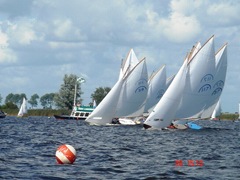Keep Clear One boat keeps clear of another if the other can sail her course with no need to take avoiding action and, when the boats are overlapped on the same tack, if the leeward boat can change course in both directions without immediately making contact with the windward boat.
In fact I've already written about this several times. So I've translated an old Dutch Post: VRIJ BLIJVEN......
KEEP CLEAR
Heard in the protest room:
- "There was no contact!"
- "He didn't have to bear away, I could pass in front of him easily"
- "His bow came so close I couldn't do anything anymore"
- "If I had luffed I would have crossed the starting line"
These statements all have to do with the definition "Keep Clear" from the Racing Rules of Sailing. Apparently there are still a lot of misunderstandings about this definition.
I every relationship between boats there's one who has the right of way (row) and one who has to keep clear (just for the sake of clarity I'm forgetting about the restrictions in rules 14 trough 18)
The definition is written from the point of view of the row boat. That boat has to be able to sail her course as if the other wasn't there.
The first 'right' of the row boat is ”no need to take avoiding action".
From the moment the row boat has the feeling 'this is not right, I have to do something', the need to take avoiding action is already there.
A few seconds later the row boat will do something, change course, he is 'feeling the need to do so' This depends not on the perception of the keep clear boat, but solely on the thoughts of the row boat.
From that moment the other boat is not 'Keeping Clear' and she has broken one of the four basic row rules. As long as the row doesn't feel the need to take avoiding action, the other is 'keeping clear'. So circumstances like force of the wind, waves, but also type of boat, speed and competence of the helmsman play a role.
Not every helmsman shall feel the need to take avoiding action at precisely the same moment. One has a better boat handling then the other. However, the rules are written to give the benefit of the doubt to the row boat.
Port and Starboard in Case 50
In a Port-Starboard protest the port boat shall have to establish that the need to take avoiding action was not there (see case 50). If there's any doubt about that, the starboard boat will win the protest.
In addition to this the row boat has another 'right'. When two boats on the same tack have an overlap and are sailing parallel, the leeward boat does not has the need to take avoiding action. There's no immediate danger she is going to be hit. That is why in the definition the second part is added. The row boat must be able to change course without immediately come in contact with the other boat. If that part of the definition was not there, she would be forced to sail in a straight line, a restriction not appropriate for a row boat.
Weather, type of boat and all other existing conditions have an impact on the distances boats can have on a race course. In a coastal race with big waves it is different then between two J22's on an inland lake. The definition is written, so that there's no fixed distance prescribed.
All questions from sailors asking what an umpire or judge would consider a 'keep clear' distance should be answered with: depends on the conditions. And that can vary from minute to minute.
When boats have contact, for sure the keep clear boat has already broken a rule BEFORE the contact. She has not 'kept clear".


"When boats have contact, for sure the keep clear boat has already broken a rule BEFORE the contact. She has not 'kept clear"." Really? How about rule 16 or rule 15? What if there is no reasonable apprehension of a collision and the ROW boat alters course violently and hits the keep clear boat?
ReplyDeleteSomewhere in the beginning of the piece I stated, for the sake of clarity, that I would forgo the restrictions of rules 14 trough 18. But of course you are right.
ReplyDeleteAlthough one could argue, that the keep clear boat wasn’t keeping clear, but is exonerated for breaking a row rule, by the infringement of the row boat of rule 15 or 16....